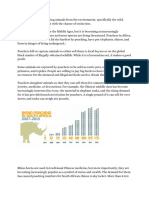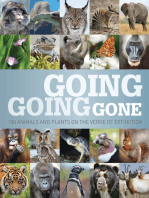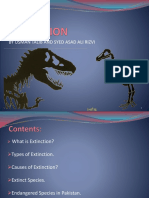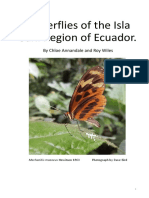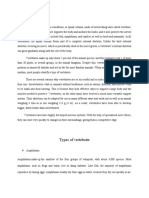Smithsonian Doc 22
Smithsonian Doc 22
Uploaded by
api-302699882Copyright:
Available Formats
Smithsonian Doc 22
Smithsonian Doc 22
Uploaded by
api-302699882Original Title
Copyright
Available Formats
Share this document
Did you find this document useful?
Is this content inappropriate?
Copyright:
Available Formats
Smithsonian Doc 22
Smithsonian Doc 22
Uploaded by
api-302699882Copyright:
Available Formats
Pudasaini 1
Endangered Species
The Smithsonian Institution is home to nine research centers and
numerous research programs with areas of inquiry spanning the globe and
the farthest reaches of the universe. My experience at the two recent exhibits held
at Natural History Museum and National Zoo, was an enthralling experience and I learnt a lot
much from these exhibits. The virtual exhibit definitely differs from my personal visit to the
museum as the personal visit to the museum gave me more insight and knowledge about
these two species. The two exhibits that I have researched are Bush African Elephant (at
Natural History Museum) and Jewels of Appalanchia (at National Zoo) which are
endangered.
Bush African Elephant
I met and spoke to a curator at the museum, who gave me a detailed review and some
information about these two species which helped understand more about them. Robert D,
Stanchik a curator at the Natural History Museum said that, the African Elephant
weighs 11 metric tons, is 13.2 feet tall and has undergone a remake! The
elephant made its debut in 1959 and has been restored several times
since then. Elephant are also known as pachyderms (Greek). This is a
reference to their very thick skin which may be more than 3cm [1 in.]
thick in places, specifically their legs and rump. Also, Stanchik, cited,
everything about the elephant is real except the tusk because the tusk
was really heavy. Elephants generally live between 60 to 70 years. The
bush elephant standing here is about 55 years old and one of the largest
in the world.
Pudasaini 2
Fig.1: Bush African Elephant
Research on the African Elephant: Elephants are both browsers and grazers, utilising a very
wide range of plants. Ecologists now classify them as mixed feeders, a term also applicable to
the Impala and Eland. Grasses are most often taken just after a rainy season, with trees and
browse making up the majority of their diet. Elephant are not very efficient feeders, not only
in their physical taking of vegetation, but also digestively. African bush elephants are
herbivores and need to eat about 350 pounds of vegetation daily (African Bush Elephant).
Elephants are organised into a number of social groups. The first and most common are large
herds led by a matriarch. This consists of a related group of females incorporating mothers,
their young, grown daughters and their offspring. Herd size may range between two and
twenty four animals, but typically 9 - 11. Male elephants leave the maternal herds at
adolescence around 12 to 19 years. Separation is a gradual process, and the adolescent bulls
may become peripheral, following the maternal herd at a distance. Their very wide array of
signals and gestures include greeting, caressing, slapping, checking reproductive condition,
rumbling, trumpeting, squealing, screaming and over 30 postures and movements covering
dominance, and threatening, defensive, submissive and fighting displays of various degrees.
Pudasaini 3
Female elephants in oestrus exhibit certain behaviours in the presence of adult bulls. Cows
out of oestrus allow any bull to check on their reproductive condition, but cows that are
nearing receptiveness acquire what is known as an oestrus walk. There are many striking
features belonging to the elephant. One is naturally the trunk. This is essentially an extended
nose. This is a very powerful organ, which is highly flexible and dextrous. The tip of the
trunk ends in two almost finger like prehensile projections, capable of some very precise coordination. The organ is used in drinking by sucking water up it, and then squirting it into the
animals mouth.
Poaching caused a decline of African elephants from 1.3 million to 600,000 individuals
between 1979 -1987. Mortality was unusually concentrated among the largest adults with the
biggest tusks. Old matriarchs (the oldest adult females that provide the social glue in elephant
herds) were particularly vulnerable. Their tusks are large and their groups were easier to find
than solitary adult males (Effects of Pouching on African Elephants). The table below shows
us that by the year 2020, all African elephants will be extinct especially due to ivory
pouching (University of Washington).
Year
Population of Elephants
1970
1300000
1980
1000000
2005
600000
2007
470000
2009
450000
2020
University of Washington (11/25/2015)
Pudasaini 4
Conservation of African Elephant: The humans are depleting the African Elephant
population as well, but through different actions including poaching. The ivory black
market is mainly supplied by elephants slaughtered in African range states such as Cameroon,
the Democratic Republic of the Congo, and Tanzania. 60 Most of the illegal large-scale
shipments of ivory in the past three years originated in Kenya and Tanzania, with 21.8 tons of
ivory having been seized from Tanzania alone (Montazeri 128) .
Elephant numbers will then be reduced in what were previously the high impact zones, thus
allowing a "recovery" phase for the vegetation, and elephants will then be allowed to increase
in the previously low impact zones. The activity of ivory pouching had decreased after the
1989 international ivory ban. This resulted in the increased number of population throughout
the world including Africa (Montazeri 133). Thus, proper rules against ivory pouching may
be made and implemented to conserve the African elephants.
Jewels of Appalachia
Most of the species unique to Appalachia belong to the Plethodontidae, a family of lungless
salamanders that breathe entirely through their skin. These salamanders are particularly
sensitive to water quality, temperature, and changes in precipitation. While some salamander
species may be able to adapt to warmer temperatures or extend their ranges northward, others
do not have these options. High-elevation species are often specialized for cool microclimates
and become easily stressed when exposed to increased temperatures or drought.
Pudasaini 5
Fig 2: Salamander
Research on the salamanders in the Appalachian Mountains: The Appalachian region is
home to more salamander species than anywhere else in the world. This region makes it a
true hotspot for salamander biodiversity. Almost half of all salamander species is listed as
threatened or endangered and population is already declining for unknown reasons. The
Appalachian region has become a primary focus of salamander conservation research and
planning.
Amphibiansfrogs, toads, salamanders, and newtsare vanishing. In fact, 42 percent of
the world's 6,000 frog species are declining rapidly and are in danger of extinction in our
lifetimes. Since 1980, 122 amphibian species are thought to have gone extinct, compared to
just five bird species and no mammals over the same period. This is an unprecedented rate of
species loss and deserves an unprecedented conservation response. Brian Gratwicke leads the
National Zoo's response to this global extinction crisis (Amphibian Conservation Program).
Salamanders will continue to decline if actions are not taken to preserve them. Thus, National
Zoo has two major focuses to conserve them. The primary focus is to preserve Panamanian
amphibious aircrafts. The secondary focus is to protect the Appalachian salamander having
unique biodiversity.
Pudasaini 6
Conservation of the Salamanders: Salamanders are very sensitive to their habitat.
(Moskwik 2).Thus, if their habitat, that is, forest structure is changed, its population
decreases. Global climate change is considered to be one of the reasons to the extinction of
salamanders in Appalachia Mountain. The activities of salamanders are governed by
moisture, particularly rain events. A rise in temperature and less frequent rain events will both
increase hydric constraints on salamanders. Shorter and less frequent opportunities to forage
and search for mates will likely result in local reductions of salamander abundance
(Montgomery, G 3). Since we cannot protect salamanders from climate change in the same
way we can mitigate pollution or habitat loss, we need to determine how each particular
species will be affected on order to develop effective strategies to help them survive. This
includes making detailed observations of the physiology of different species, their current
ranges, and ability to withstand or adapt to climate change. Finally, raising salamanders in
capacity will establish an assurance colony to guard against extinction in the wild and provide
us with more opportunities for research.
Common Link between the two exhibits:
I did my research and found out that the common link between the two exhibits is that the
salamanders in the Appalachian Mountains and the African elephant are both endangered
species and the detrimental effect humans are having on animal species across the world. The
salamanders in the Appalachian Mountains and their habitats are being destroyed by human
construction and pollution. In the same way, human beings are depleting the African Elephant
population as well, but through different actions including poaching.
In conclusion, population of Salamanders falling in Amphibian family and African elephants
falling in the mammal family are decreasing. The researchers suggest that people should try
to conserve these species and help these species and their environment so that our future
Pudasaini 7
generations will be able to see them. Only if government implements some new rules to
protect such endangered species will they be conserved.
Works Cited
African Bush Elephant | The Nature Conservancy. African Bush Elephant | The Nature
Conservancy. N.p, n.d Web. 06 Dec 2015.
Pudasaini 8
Effect of Poaching on African Elephants. Center for Conservation Biology. N.p, n.d Web.
06 Dec 2015.
Montazeri Sharon. Protecting the Pachyderm: The significance Of Ivory Trade regulation
For African Elephant Conservation. Cordozo Journal Of International & Comparative Law
22.1(2013):121-152 Academic search complete Web. 6 Dec. 2015
Moskwik, Matthew. Recent Elevational Range Expansions In Plethodontid Salamanders
(Amphibia: Plethodontidae) In The Southern Appalachian Mountains. Journal of
Biogeography 41.10 (2014): 1957-1966. Environment Complete. Web. 6 Dec. 2015.
Amphibian Conservation Program. National Zoo N.p, n.d Web. 06 Dec 2015.
Montgomery, G. Gene. The Ecology of Arboreal Folivores : A Symposium Held at the
Conservation and Research Center, National Zoological Park, Smithsonian Institution, may
29-31, 1975/.(1978): n pag. Web.
You might also like
- Donald L. Grebner, Pete Bettinger, Jacek Siry, Kevin Boston - Introduction To Forestry and Natural Resources-Academic Press (2021)Document513 pagesDonald L. Grebner, Pete Bettinger, Jacek Siry, Kevin Boston - Introduction To Forestry and Natural Resources-Academic Press (2021)Jebby EtheimNo ratings yet
- Environmental Conditions Assessment: Burnaby Mountain Conservation AreaDocument52 pagesEnvironmental Conditions Assessment: Burnaby Mountain Conservation AreaDustin GodfreyNo ratings yet
- Sad Eyes Empty LivesDocument4 pagesSad Eyes Empty LivesSheikh ErasNo ratings yet
- Poaching ProjectDocument12 pagesPoaching ProjectSimeonNo ratings yet
- Death of The Natural KritikDocument52 pagesDeath of The Natural KritikSatish Vemuri100% (3)
- Biogeography - WikipediaDocument6 pagesBiogeography - Wikipediaskline3No ratings yet
- What Is The African ElephantDocument6 pagesWhat Is The African ElephantNovaldi Luviano SangerNo ratings yet
- Animal Extinction and Preservation - Animal Books | Children's Animal BooksFrom EverandAnimal Extinction and Preservation - Animal Books | Children's Animal BooksNo ratings yet
- The African Forest ElephantDocument6 pagesThe African Forest ElephantJames Remington Orozco NewtonNo ratings yet
- Media CommentaryDocument3 pagesMedia Commentaryabigail.arnoldNo ratings yet
- Animals Category Description: From The Presentation, Convert The Information Into The TableDocument8 pagesAnimals Category Description: From The Presentation, Convert The Information Into The TableSyaheera MyNo ratings yet
- "Extinct" Amphibians Rediscovered After Nearly Half A CenturyDocument3 pages"Extinct" Amphibians Rediscovered After Nearly Half A CenturyCHRISTIAN SORIANONo ratings yet
- Dupla 15. EnglishDocument4 pagesDupla 15. Englishgeovanasousa20082008No ratings yet
- Niche of African ElephantsDocument3 pagesNiche of African ElephantsAbdulrahman JijawiNo ratings yet
- African Elephants EssayDocument2 pagesAfrican Elephants EssayjorgeNo ratings yet
- TP Comprensión (CON CORRECCIONES) - Varas, García, Echeverría, Cañupan, PerezDocument14 pagesTP Comprensión (CON CORRECCIONES) - Varas, García, Echeverría, Cañupan, PerezFlor PerezNo ratings yet
- The Endangered Mammals from Around the World : Animal Books for Kids Age 9-12 | Children's Animal BooksFrom EverandThe Endangered Mammals from Around the World : Animal Books for Kids Age 9-12 | Children's Animal BooksNo ratings yet
- Falling Stars: 10 of The Most Famous Endangered Species: Giant Panda (Ailuropoda Melanoleuca)Document6 pagesFalling Stars: 10 of The Most Famous Endangered Species: Giant Panda (Ailuropoda Melanoleuca)Lob NaNo ratings yet
- ReptileDocument4 pagesReptileDratonius 101No ratings yet
- Elephants: FactsDocument4 pagesElephants: FactsAngelo HuligangaNo ratings yet
- The Rarest Animal in The World: Amur LeopardDocument4 pagesThe Rarest Animal in The World: Amur LeopardPrincess Kaye MontefalcoNo ratings yet
- Report Text About PandaDocument17 pagesReport Text About PandaAndre Andrian0% (1)
- White Rhinoceros: San Diego Wild Animal ParkDocument15 pagesWhite Rhinoceros: San Diego Wild Animal ParkJyotirmoy ThakuraNo ratings yet
- Zoology EssayDocument5 pagesZoology Essayapi-437292599No ratings yet
- Paraphrasing ElephantsDocument8 pagesParaphrasing Elephantsapi-253899620No ratings yet
- The 20 Weird Animals YouDocument3 pagesThe 20 Weird Animals YouDanie AlonzoNo ratings yet
- Frogs vs. Toads: CaeciliansDocument2 pagesFrogs vs. Toads: CaeciliansZonny Zivins PresentsNo ratings yet
- Giant Panda (Ailuropoda Melanoleuca) : Jeff Tinsley/Smithsonian InstitutionDocument3 pagesGiant Panda (Ailuropoda Melanoleuca) : Jeff Tinsley/Smithsonian InstitutionSuryajeeva SuresNo ratings yet
- Extinct and Endangered Animals OF INDIADocument8 pagesExtinct and Endangered Animals OF INDIASunil100% (2)
- Walking With Cavemen Episode GuideDocument11 pagesWalking With Cavemen Episode GuideVan der WaalsNo ratings yet
- Endangered Species Eatherback Sea Turtle: SourceDocument4 pagesEndangered Species Eatherback Sea Turtle: SourcechetanNo ratings yet
- Blank 5Document13 pagesBlank 5Shehab IbrahimNo ratings yet
- Endangered Vs Endemic Species - BiologyDocument4 pagesEndangered Vs Endemic Species - BiologyBhavya SampatNo ratings yet
- Going, Going, Gone: 100 animals and plants on the verge of extinctionFrom EverandGoing, Going, Gone: 100 animals and plants on the verge of extinctionRating: 5 out of 5 stars5/5 (1)
- World Wildlife DayDocument35 pagesWorld Wildlife DayLeah Liza CasandaNo ratings yet
- By Usman Talib and Syed Asad Ali RizviDocument14 pagesBy Usman Talib and Syed Asad Ali RizviMajid AliNo ratings yet
- Endangered SpeciesDocument2 pagesEndangered SpeciesspiritusNo ratings yet
- Aniamls in DangerDocument12 pagesAniamls in DangerGisselle AlemánNo ratings yet
- IE2 Course Pack - Reading MaterialDocument15 pagesIE2 Course Pack - Reading MaterialKim Hoang TaNo ratings yet
- Saola FactsDocument29 pagesSaola FactsMeo MeoNo ratings yet
- 10 Endangered Animals in MalaysiaDocument6 pages10 Endangered Animals in Malaysianadia_halid_1No ratings yet
- Endangered Species ExhibitDocument45 pagesEndangered Species Exhibitvagrawal2502No ratings yet
- Peruvian Amazonia and Its BiodiversityDocument13 pagesPeruvian Amazonia and Its BiodiversityGerard PalaciosNo ratings yet
- Snake - Britannica Online EncyclopediaDocument13 pagesSnake - Britannica Online Encyclopediamayank.sharma789594No ratings yet
- Source: 1. 2.: 1. Giant PandaDocument2 pagesSource: 1. 2.: 1. Giant PandachetanNo ratings yet
- Contoh Report TextDocument20 pagesContoh Report TextNovia Rahmawati FauziyahNo ratings yet
- Book Butterflies of The Sani Region EbookDocument106 pagesBook Butterflies of The Sani Region EbookMiguel VintimillaNo ratings yet
- CALISTON, Rod Daniel (Lab 2)Document3 pagesCALISTON, Rod Daniel (Lab 2)Rod Daniel CalistonNo ratings yet
- Sloth: This Article Is About The Central and South American Mammal. For The Cardinal Sin, See - For Other Uses, SeeDocument6 pagesSloth: This Article Is About The Central and South American Mammal. For The Cardinal Sin, See - For Other Uses, SeeAlexandra LicaNo ratings yet
- Camel Milk AssingmentDocument19 pagesCamel Milk AssingmentNada Fawzy AhmedNo ratings yet
- Non-Human Primate PaperDocument6 pagesNon-Human Primate Papermatt14.castilloNo ratings yet
- MyClass PC Adv 77Document5 pagesMyClass PC Adv 77rebecaNo ratings yet
- White-Backed VultureDocument7 pagesWhite-Backed Vulturejosh321No ratings yet
- RHINOSDocument7 pagesRHINOStheinvisibleminecrafterNo ratings yet
- Facts About The LionDocument5 pagesFacts About The LionMas Eko JechNo ratings yet
- Report On Endangered and Rare SpeciesDocument4 pagesReport On Endangered and Rare SpeciesIshita AgarwalNo ratings yet
- Text ReportDocument6 pagesText Reportgentarevolusi63No ratings yet
- Vertebrate and InvertebratesDocument9 pagesVertebrate and InvertebratesgwenethzNo ratings yet
- Extinct Animals: Presented by Eman Zafar From Class 7-ADocument8 pagesExtinct Animals: Presented by Eman Zafar From Class 7-AMeerab UsmanNo ratings yet
- AnimalDocument22 pagesAnimalJudin BellNo ratings yet
- The Platypus (Ornithorhynchus Anatinus)Document3 pagesThe Platypus (Ornithorhynchus Anatinus)Toàn LêNo ratings yet
- 4module in Environmental ScienceDocument5 pages4module in Environmental ScienceVirgie OrtizNo ratings yet
- Oposa V FactoranDocument15 pagesOposa V FactoranGen GrajoNo ratings yet
- Hypsipyla Shoot Borers in MeliaceaeDocument176 pagesHypsipyla Shoot Borers in Meliaceaecarrie hauxwellNo ratings yet
- Essay On Asian Elephant ConservationDocument2 pagesEssay On Asian Elephant ConservationDinesh Kumar PNo ratings yet
- Captive OrcasDocument104 pagesCaptive OrcasAB100% (1)
- pdf1668196795882 PDFDocument59 pagespdf1668196795882 PDFHanna AdebachoNo ratings yet
- Mrunal - Environment and BiodiversityDocument104 pagesMrunal - Environment and BiodiversityVirendra PratapNo ratings yet
- Waste Not Want Not SummaryDocument17 pagesWaste Not Want Not SummaryYoucef FBNo ratings yet
- Water Measurement ManualDocument317 pagesWater Measurement ManualefcarrionNo ratings yet
- OLD BOOK MEV-001 - Environment and EcologyDocument283 pagesOLD BOOK MEV-001 - Environment and EcologySi KriNo ratings yet
- syllabus of environmental scienceDocument2 pagessyllabus of environmental scienceindradevkumar1140No ratings yet
- GMRC YanalaoDocument12 pagesGMRC Yanalaolaoyana9No ratings yet
- Vol2of3 - Draft - EIA - KuisebDelta - DuneBeltAreas - April 2012 PDFDocument203 pagesVol2of3 - Draft - EIA - KuisebDelta - DuneBeltAreas - April 2012 PDFbeataNo ratings yet
- ESL assignment 2 YGN (80 marks)Document16 pagesESL assignment 2 YGN (80 marks)internationalmakkhayarNo ratings yet
- Archeological and Historical Background Study of Castner Range, Fort Bliss Military Installation, El Paso County, Texas Prepared For Castner Range National Monument byDocument40 pagesArcheological and Historical Background Study of Castner Range, Fort Bliss Military Installation, El Paso County, Texas Prepared For Castner Range National Monument byJohnMezaNo ratings yet
- (문법 공략) 5.Our Earth Our Future Our Choice (01) - 천재 (이재영) 고1 영어 (Document6 pages(문법 공략) 5.Our Earth Our Future Our Choice (01) - 천재 (이재영) 고1 영어 (86vb52dqhsNo ratings yet
- MoEF Manual - Highways-May 2010 PDFDocument117 pagesMoEF Manual - Highways-May 2010 PDFShashi ShankarNo ratings yet
- Year 6 - Science Keypoint NotesDocument8 pagesYear 6 - Science Keypoint Notesteddyen100% (2)
- Rangelands: Overgrazing Deforestation DesertificationDocument35 pagesRangelands: Overgrazing Deforestation DesertificationNoah AusejoNo ratings yet
- Wild Life ConservationDocument15 pagesWild Life ConservationRashmeet Kaur BangaNo ratings yet
- A Survey With A Lifelong FishermanDocument7 pagesA Survey With A Lifelong FishermanDaniella Jirah MamarilNo ratings yet
- Previous Year Questions - EcosystemDocument2 pagesPrevious Year Questions - Ecosystemsj.99999007No ratings yet
- A Demonstration Lesson Plan in Science and HealthDocument2 pagesA Demonstration Lesson Plan in Science and HealthStupidMonkey Juancho93% (14)
- Green Building Rating Systems in IndiaDocument4 pagesGreen Building Rating Systems in IndiaDivyesh ParsanaNo ratings yet
- South Asian Amphibians - Taxonomy, Diversity and Conservation StatusDocument15 pagesSouth Asian Amphibians - Taxonomy, Diversity and Conservation StatusRegina Joyce E. FerrerNo ratings yet
- Bai Tap Tu Vung Doc Hieu Anh 9 Global Unit 7 Natural Wonders of The WorldDocument14 pagesBai Tap Tu Vung Doc Hieu Anh 9 Global Unit 7 Natural Wonders of The Worldkhanhquynhnguyen6a1No ratings yet



